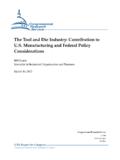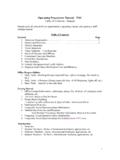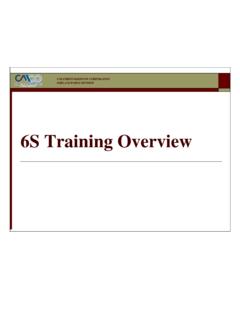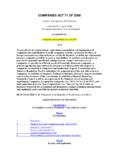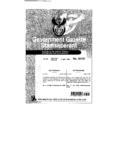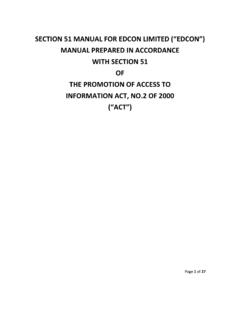Transcription of ESOP - National Tooling and Machining Association
1 ESOP FactsEmployee Stock Ownership Plans: An OverviewHow ESOPs WorkAre ESOPs Really More Complex than Other Ways to Sell a Business?America s Largest Majority Employee-Owned CompaniesESOP Limitations: How Small is Too Small?Operating an ESOP SuccessfullyESOPs in S Corporationsn SPECIAL OFFERS FOR ATTENDEES n NCEO MEMBERSHIP AND ORDER FORM their origin in 1956, the number of employee stock ownership plan (ESOP) companies has grown to almost 11,000. ESOPs are used for many reasons, including providing for a tax-favored, flexible transition of ownership in closely held companies and as a means of providing an additional benefit that ties employee and company interests together. ESOP companies outperform conventional companies , are less likely to lay people off, and generate substantial retirement assets for employees.
2 Despite their growth and success relatively few people know about them, and people who do often have profound misconceptions about how they Many ESOPs are There?As of 2012, the National Center for Employee Ownership (NCEO) estimates there are approximately 10,900 companies with ESOPs or substantially equivalent plans. Counting other forms of employee ownership of company stock, the NCEO calculates that approximately 25 million employees participate in an employee ownership plan. These numbers are estimates, but are probably conservative. Overall, employees now control about 8% of corporate equity. Although other plans now have substantial assets, most of the estimated 4,000 majority employee-owned companies have Ownership and Corporate PerformanceA 2000 Rutgers study found that ESOP companies grow to faster after setting up their ESOP than would have been expected without it.
3 companies that combine employee ownership with employee workplace participation programs show even more substantial gains in performance. A 1986 NCEO study, confirmed by several subsequent academic studies, found that employee ownership firms that practice participative management grow 8% to 11% per year faster with their ownership plans than they would have without them. Note, however, that participation plans alone have little impact on company performance. How ESOPs WorkIn an ESOP, companies set up a trust fund for employees and either contribute cash to buy company stock, contribute shares directly to the plan, or have the plan borrow money to buy shares. If the plan borrows money, the company makes contributions to the plan to enable it to repay the loan. Employee contributions are almost never involved. After participants leave the company, they either sell the shares in their account on the market or sell them back to the company or the plan.
4 The Employee Retirement Income Security Act (ERISA) provides a regulatory framework for plan participation, vesting, benefit distribution, diversification, and more. The ESOP trust must act for the exclusive benefit of plan IssuesIn S corporations, earnings attribu-table to the ESOP s ownership share in S corporations are not taxable. In other words, if an ESOP owns 100% of a company s stock, the company is not subject to federal, and often state, income tax. In C corporations, provided that an ESOP owns 30% of company stock and the seller meets certain requirements, owners of a private firm selling to an ESOP can defer taxation on their gains by reinvesting in securities of other companies . In either type of company contributions to the plan are tax-deductible. Employees pay no tax on the contributions until they receive the stock when they leave or retire.
5 How Employees FareParticipants in ESOPs do well. A 1997 Washington State study found that ESOP participants earned 5% to 12% more in wages and had almost three times the retirement assets as did workers in comparable non-ESOP to a 2010 NCEO analysis of ESOP company government filings in 2008, the average ESOP participant receives about $4,443 per year in company contributions to the ESOP and has an account balance of $55,836, both of which are substantially higher than people in comparable non-ESOP companies . People in the plan for many years would have much larger balances. In addition, 56% of the ESOP companies have at least one additional defined contribution retirement plan. By contrast, only about 44% of all companies otherwise comparable to ESOPs have any retirement plan, and many of these are funded entirely by of Major ESOP CompaniesESOPs can be found in all kinds of sizes of companies .
6 Some of the more notable majority employee-owned companies are Publix Supermarkets (over 152,000 employees), Nypro (17,000 employees), Lifetouch (26,000 employees), Gore and Associates (maker of Gore-Tex, 9,000 employees), and Davey Tree Company (7,000 employees). companies with ESOPs and other broad-based employee ownership plans account for well over half of all the 100 Best companies to Work for in America year after Stock Ownership Plans: An National Center for Employee OwnershipESOP FactsHow ESOPs Workvote their allocated shares on major issues, such as closing or relocating, but the company can choose whether to pass through voting rights (such as for the board of directors) on other issues. In public companies , employees must be able to vote all for ESOPs nTo buy the shares of a departing owner: The owner of a privately held corporation either can use an ESOP to acquire his or her shares all at once or can sell some shares now and some later.
7 Under this approach, the company can make tax-deductible cash contributions to the ESOP to buy out an owner s shares, or it can have the ESOP borrow money to buy the shares with the loan being repaid in pre-tax dollars. nTo borrow money at a lower after-tax cost: The ESOP trust borrows cash, which it uses to buy company shares or shares of existing owners. The company then makes tax-deductible contributions to the ESOP to repay the loan, meaning both principal and interest are deductible. nTo create an additional employee benefit: companies tend to contribute more generously to ESOPs than to comparable benefit plans, and the increase in stock value can create a substantial employee benefit. In addition, ownership is a natural fit with high performance workplace practices and creating an engaged workforce, and companies that have high levels of job attractive as these benefits are, however, there are limits and drawbacks.
8 The law does not allow ESOPs to be used in partnerships and most professional corporations. Private companies must repurchase shares of departing employees, and this can become an ongoing expense that needs to be planned for. The cost of setting up an ESOP is also ESOP RulesAn ESOP is an employee benefit plan, with some similarities to both profit-sharing plans and 401(k) plans. One key difference is that ESOPs are required to primarily hold company stock. companies may contribute new shares ,or they may contribute cash to buy existing shares. An alternative and more common approach is for the ESOP trust to borrow money to buy new or existing shares. The company then makes cash contributions to the plan to enable it to repay the loan. The ability to borrow money is another difference from other benefit plans. Regardless of how the plan acquires stock, company contributions to the trust are tax-deductible, within certain there are some exceptions, generally all full-time employees over 21 participate in the plan.
9 Shares in the trust are allocated to individual employee accounts. When a loan was used to purchase stock, the shares are allocated as the loan is paid off. Otherwise, the allocation happens immediately after the contribution. Allocations are made either on the basis of relative pay or some more level formula. As employees remain actively employed at the firm, they acquire an increasing right to the shares in their account, a process known as vesting. Federal law requires that employees become 100% vested in no more than three years for a cliff vesting schedule, and in no more than six years for step employees leave the firm, they receive their stock not later than six years after they leave unless they retire, die, or become disabled. In those cases, payment generally starts after one year. The company must buy back the shares at their fair market value (unless there is a public market for the shares), although companies can spread this repayment over time.
10 Private companies must have an annual outside valuation to determine the price of their shares. In private companies , employees must be able to substantial $40,000 to $60,000 for the simplest of plans in small companies and increasingly more costly for larger firms and/or more complex plans (although the cost of selling a company to an outsider is several times this). ESOPs also generally cost about four times as much to administer as comparable 401(k) plans. Any time new shares are issued, the stock of existing owners is diluted. That dilution must be weighed against the tax and motivation benefits an ESOP can provide. Finally, ESOPs will only improve corporate performance if combined with opportunities for employees to participate in decisions affecting their work. Key Feasibility Questions nAre the costs worth the benefits?


